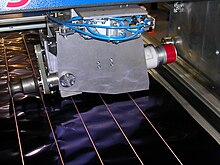
Back لحام فوق صوتي Arabic Soldadura ultrasònica Catalan Ultraschallschweißen German Soldadura ultrasónica Spanish جوش اولتراسونیک Persian Ultrazvučno zavarivanje Croatian Ուլտրաձայնային եռակցում Armenian Saldatura a ultrasuoni Italian 超音波接合 Japanese 초음파 용접 Korean

Ultrasonic welding is an industrial process whereby high-frequency ultrasonic acoustic vibrations are locally applied to work pieces being held together under pressure to create a solid-state weld. It is commonly used for plastics and metals, and especially for joining dissimilar materials. In ultrasonic welding, there are no connective bolts, nails, soldering materials, or adhesives necessary to bind the materials together. When used to join metals, the temperature stays well below the melting point of the involved materials, preventing any unwanted properties which may arise from high temperature exposure of the metal.[1][2]
- ^ Hiromichi T. Fujii, Yuta Goto, Yutaka S. Sato, and Hiroyuki Kokawa (February 2016). "Microstructure and lap shear strength of the weld interface in ultrasonic welding of Al alloy to stainless steel". Scripta Materialia. 116. ELSEVIER: 135–138. doi:10.1016/j.scriptamat.2016.02.004. Retrieved 2017-07-04.
{{cite journal}}: CS1 maint: multiple names: authors list (link) - ^ Mostafavi, Shimaalsadat; Hesser, Daniel Frank; Markert, Bernd (December 2018). "Effect of process parameters on the interface temperature in ultrasonic aluminum wire bonding". Journal of Manufacturing Processes. 36: 104–114. doi:10.1016/j.jmapro.2018.09.020. S2CID 139828540.
© MMXXIII Rich X Search. We shall prevail. All rights reserved. Rich X Search